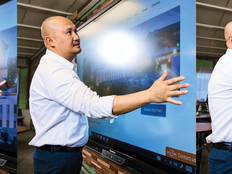“There’s an awareness now that all teachers should understand that everyone sitting before them has a different way of learning,” says Luisa Manzo, who began working with the organization this school year as a field representative for special education.
In addition to training teachers and creating staff positions dedicated to special education, the Catholic Schools of Brooklyn and Queens also turned to technology to support different ways of learning.
Data Introduces Personalized Learning to Schools with Small Classes
The educators at the Catholic Schools of Brooklyn and Queens needed to know where students struggled and where they thrived before they could provide individualized support, O’Brien says. To measure their understanding of a topic and establish a baseline for tracking their progress, the schools turned to an online assessment program.
“Students use their devices to take three diagnostics throughout the course of the year — one in the fall, one in the winter and one in the spring — in both reading and in math, and it gives instant results,” O’Brien says. Educators can then use these results to tailor lessons and create personalized learning plans for students.
DIVE DEEPER: Technology supports personalized learning in K–12 schools.
“Learning gets to be individualized for students who really struggle or who have some insecurities when it comes to tackling certain topics,” Manzo says. “Inclusive classrooms need differentiation to make sure that students’ instruction is being tailored to their needs.”
Now, students can work in small groups in their classes and use their devices to learn at their own speed or conduct research for project-based learning.
“The older students can be let loose to research, to create, to collaborate with their classmates, harness that technology and come up with a finished product,” O’Brien says. “In general, the younger students are using that technology on their personalized learning paths. Nearly all of our curriculum materials have a digital component.”











